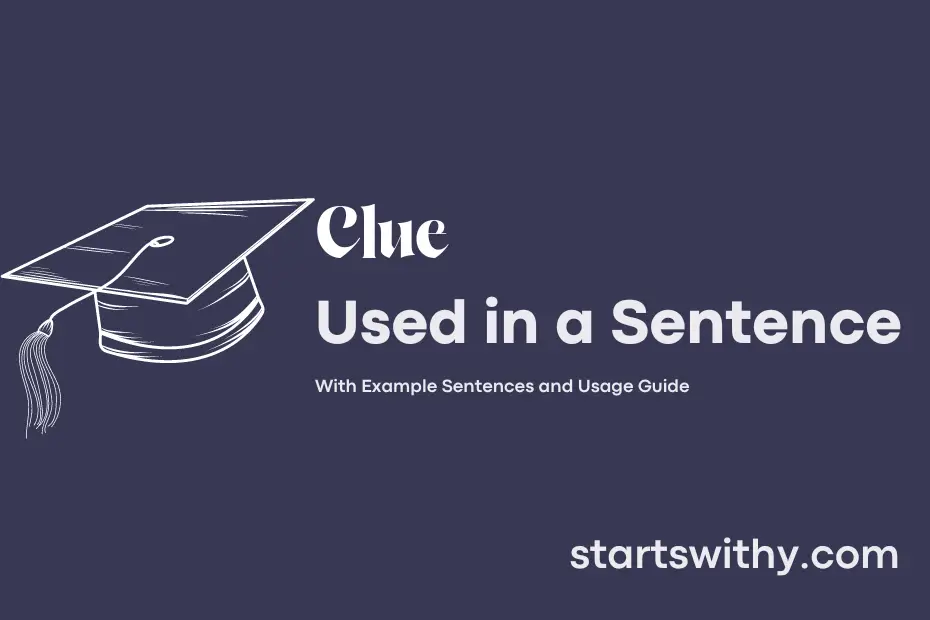Have you ever struggled to understand the meaning of a word or phrase when reading or listening to someone speak? A clue can provide vital insight into the context or explanation, making it easier to grasp the message being conveyed.
In language learning, a clue serves as a valuable tool in deciphering unfamiliar vocabulary or complex ideas. By recognizing and interpreting clues within a sentence or conversation, learners can improve their comprehension and expand their knowledge base.
7 Examples Of Clue Used In a Sentence For Kids
- Look for the clue hidden under the tree.
- The map will show us the clue to find the treasure.
- Follow the footprints to find the secret clue.
- The detective used a magnifying glass to search for the tiny clue.
- The shiny object on the ground is a helpful clue.
- Let’s work together to solve the mystery clue.
- I found a mysterious note that might be a valuable clue.
14 Sentences with Clue Examples
- Clue: When you’re stuck on an assignment, ask a classmate for a clue.
- Make sure to read the syllabus carefully for any clues about the upcoming exam.
- Clue: Check the library website for any clues on where to find certain books.
- Sometimes the professor will drop clues about what will be on the test during lectures.
- Clue: Look for any clues in the textbook to help you solve the problem.
- Form a study group to share clues and insights on difficult subjects.
- Clue: Pay attention to your professor’s body language for any clues on important information.
- Don’t overlook any clues given during guest lectures- they could be crucial for your understanding.
- Clue: Use the index in the back of the textbook to find helpful clues for your research paper.
- Make use of online forums to share and discover clues for challenging assignments.
- Clue: Look for any clues in the footnotes that could lead you to additional sources.
- Keep your eyes open for any clues or hints given by your teacher for the final project.
- Clue: Review your old exams for clues on how to better prepare for future tests.
- Don’t forget to ask your seniors for any clues they may have about navigating campus life successfully.
How To Use Clue in Sentences?
Clue can be used in a sentence to provide evidence or indicate information that leads to solving a mystery or puzzle. In a sentence, the word Clue typically comes before or after the piece of information it refers to.
For example, in the sentence “The detective found a clue at the crime scene,” Clue is used to show that the detective discovered an important piece of evidence that may help solve the crime. Clue can also be used to suggest a hint or indication that points towards a specific solution.
Another example is “She gave me a clue about where to find the missing keys.” Here, Clue is used to signify that the woman provided helpful information or a lead on where the keys might be located.
When using the word Clue in a sentence, it is important to ensure that it is clear and appropriately placed to convey the intended meaning. Pay attention to the context in which Clue is used and make sure it fits logically within the sentence structure.
By incorporating Clue effectively into your sentences, you can enhance communication and provide valuable information or hints to help others understand and solve a mystery or puzzle.
Conclusion
In conclusion, sentences with clues are essential for guiding readers towards understanding the context, solving mysteries, or drawing conclusions in various written works. Throughout literature, these sentences serve as keys that unlock hidden meanings, allowing readers to delve deeper into the text and unravel its secrets. By incorporating clues into their writing, authors can engage readers, pique their curiosity, and enhance the overall reading experience.
Whether it’s a subtle hint, a well-placed detail, or a cleverly crafted phrase, sentences with clues play a crucial role in shaping the narrative, facilitating comprehension, and keeping readers invested in the story. From detective novels to academic texts, these clues enrich the reading experience, inviting readers to piece together information, make connections, and ultimately uncover the underlying message or plot points within the text.



